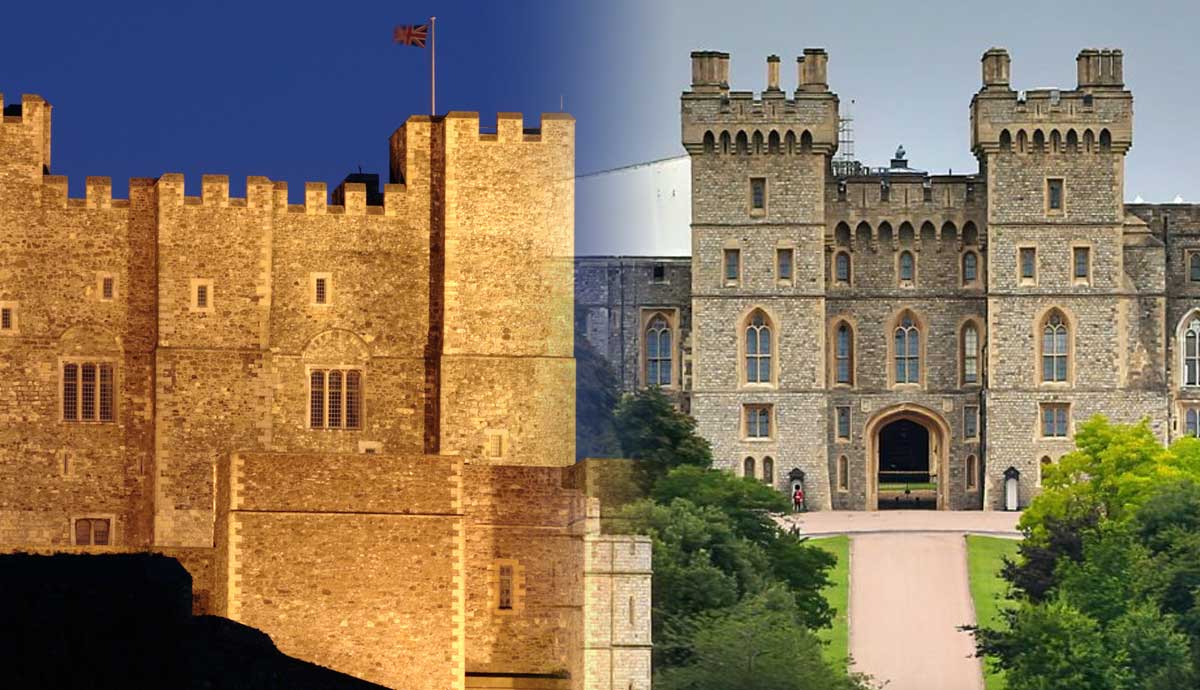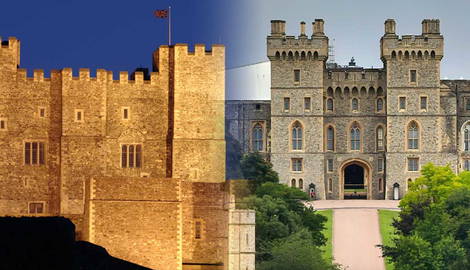
England’s cities and rural landscapes are littered with castles, many first erected under William the Conqueror almost a millennium ago. A few have survived completely intact as aristocratic seats or modern defensive nodal points. Many more were partially destroyed after the English Civil War to become the kind of spectral ruins that caught the imaginations of the Romantics. We will look at six essential but very different English castles and dive into what makes them so fascinating.
1. Portchester Castle

At the northern tip of Portsmouth Harbor on England’s south coast, a tall 14th-century keep is enclosed by ancient walls.
As well as being a Norman castle, established by an advisor to William the Conqueror, Portchester Castle is also the best-preserved Roman fort north of the Alps. Founded as Portus Adurni, the outer bailey has all the telltale signs of a Roman stronghold, with its square configuration and semi-circular towers.
The Roman fort was most likely built under Diocletian in the late 3rd century CE to defend a slice of the south coast against pirates. This was the beginning of many centuries of unbroken occupation, with a Saxon settlement taking shape in the 10th century.
The Normans built their castle in the northwest corner of the old fort, surrounding their keep with a moat and a wooden palisade. From the Middle Ages, Portchester was a point of departure for armies making the crossing to France, and the castle was enhanced dramatically in the 12th century.
For the next 400+ years, Portchester Castle had royal status, and the keep took on a suitable degree of sophistication. Henry II (1133-1189) and King John (1166-1216) both spent a lot of time here. In 1415, Henry V launched his invasion of France from here, culminating in his victory at the Battle of Agincourt.
As well as being an embarkation point, the complex became a convenient prison. From the 17th to the 19th century prisoners from a succession of wars were kept within the square outer walls. Among them were Dutch and French soldiers, including 2,500 black and mixed-heritage men in 1796. Enlisted by the French Revolutionary Army, they had been captured when the British took the island of St. Lucia.
2. Dover Castle

At the point of the shortest sea crossing between England and France, Dover Castle sits atop the iconic white cliffs and has long been known as the key to England. This spot has had strategic importance since before the Romans and has a tale to tell from every chapter of its storied past.
The earthworks at Dover Castle, with their snaking outline and massive enclosed area, bear no comparison to anything from the Middle Ages and most likely belonged to an Iron Age hillfort.
Later, in the 2nd Century CE, the Romans built an octagonal lighthouse on the site. Remarkably, it is still standing today as one of just three surviving Roman lighthouses in the world. Since around the 7th century it has served as the belltower for the St Mary sub Castro church.
After the Norman Conquest, Dover became one of the Cinque Ports, a confederation of harbor towns vital for trade and defense. Under Henry II in the 12th century, the castle atop the cliffs became a cutting-edge piece of military architecture. At the heart of the complex comprising an inner and outer bailey was the Great Tower. Still intact, this structure mixed defensive prowess with opulence.

Dover Castle stood up to three sieges in the 13th century and gradually faded into obsolescence with the arrival of gunpowder in the Early Modern Period. There was a Royalist garrison here in the Civil War, captured by a small Parliamentarian detachment that scaled the cliffs and entered the castle after dark without a shot being fired.
By the time of the French Revolution, Dover was a garrison town, and the castle was brought up-to-date with the largest project since the reign of Henry II. This involved raising new earthworks, lowering the walls, and building a series of gun positions and casemates.
The Dunkirk evacuation was coordinated in these Napoleonic tunnels in the summer of 1940, as was the operation to deceive the Wehrmacht about the exact location of the D-Day Landings in 1944.
3. Tower of London

One of the most recognizable landmarks in the country, the Tower of London held sway over London from its southeasternmost limits. For centuries it represented the political power of the monarchy and it is enmeshed in the history of state institutions like the Royal Mint.
Part of the immense program of defensive construction that swept England during the Norman Conquest, the Tower of London was at the forefront of military construction technology in the Middle Ages.
When it was completed in the late 11th century, it was one of the largest buildings of any kind in Western Europe. Almost impenetrable, its imposing outer appearance concealed a palatial interior that flourished and grew more refined from the 11th to the 16th century. The remaining residential buildings offer an unmatched insight into the domestic life of England’s monarchs.
The keep, known as the White Tower, has made it through the centuries with few changes. The remainder of the complex was enhanced by Henry III, amid the instability of the 13th-century Barons’ Wars.
Later that century, the prolific castle-builder Edward I made the castle siege-proof by improving the curtain wall. Most of this work survives, like the Beauchamp Tower on the west side, which was the first large-scale brick structure raised in England since Roman times. From that period onwards, the complex filled an important storage role, holding important documents and precious items. The Crown Jewels are still here, as is a portion of the Royal Armouries.
There are layers upon layers of history in situ, while volumes of momentous historical events have taken place within these walls. Three queens of England—Anne Boleyn, Catherine Howard, and Lady Jane Grey—were executed here in the 16th century. In 1483, this is also where the Princes in the Tower (the deposed young King Edward V and his brother) were lodged when they disappeared.
4. Middleham Castle

Slowly decaying since the 1600s, Middleham Castle was once a residence for one of the most powerful families in the country. From 1248 to the late 15th century, this Lordship in the Yorkshire Dales belonged to the Nevilles. The “Kingmaker,” Richard Neville, 16th Earl of Warwick (1428-1471) was a key player in the Wars of the Roses, starting out as a Yorkist and later defecting to the Lancastrians.
One figure brought into Warwick’s care was the future Richard III (1452-1485), whose father Richard of York died at the Battle of Wakefield in 1460. Richard III spent many of his teenage years at Middleham Castle, while his older brother Edward IV was a guest here; Warwick would later turn against Edward and he was killed at the Battle of Barnet in 1471.
As king, Richard was an occasional resident here before his famous death at the Battle of Bosworth Field in 1485. Sometime in the 1470s, Richard III’s only legitimate child, Edward of Middleham was born here, but he only survived to the age of seven or ten.

The castle was already in decay by the mid-16th century, and, after holding a Parliamentary garrison in the 1650s, was completely abandoned after the Civil War.
And yet, despite almost 400 years of ruin, Middleham Castle is in good shape. The Norman Keep, one of the largest in the UK, dates to the mid-12th century and is reinforced by a tower on the east side from the early 13th century. The keep is surrounded to the north, west, and south by a curtain wall, built in the early 14th century and still reaching its original height.
Among the many interesting things to observe at Middleham Castle are the domestic rooms in the inward-facing ranges of the curtain wall. Although skeletal today, they indicate the transformation of the castle from an austere stronghold into a plush baronial residence for the Nevilles in the 14th century.
5. Windsor Castle

It is impossible to overlook this royal residence, the name of which was adopted by the current Royal Family in 1917. For one thing, Windsor Castle has held onto much of its Medieval military architecture, even if it was reworked in a more theatrical style in the 19th century.
Decades after being built by William the Conqueror as part of a defensive ring around London, Windsor Castle became a royal residence and has remained so almost without interruption, for more than 900 years. This makes it the oldest occupied castle in the world, home of 40 kings and queens.
The castle was besieged during the first Barons’ War in the early 13th century but is less a place of violence or political intrigue. Instead, Windsor Castle was for leisure, where kings took hunting trips and caroused. One early 17th-century drinking session here, involving James I and Christian IV of Denmark, caused a scandal across Europe.
Windsor Castle is also a place of burials at the splendid St George’s Chapel. The Chapel is held as a high point for English Perpendicular Gothic architecture, with a sublime stellar and fan vault ceiling.
Aside from an interruption when the 18th-century Hanovers were absent, successive monarchs left their mark. The consequence is a patchwork of interior styles, from Charles II’s Baroque chambers and dining room to George IV’s late Rococo Grand Reception Room. Added to that is an extraordinary collection of paintings and other works of decorative art, spanning busts of kings, portraits by Rubens and van Dyck, and centuries of metalwork and porcelain.
6. Warwick Castle

Standing upon a sandstone outcrop at a loop on the River Avon, Warwick Castle fits with most people’s idea of a fairytale castle. This property is owned by Merlin Entertainments, which maintains Legoland parks around the world.
So while there are hundreds of years of compelling history, it all comes with a dose of showmanship. That means 200 days of events every year, with jousting, sword fighting, and bird of prey demonstrations.
Warwick Castle began as a wooden motte-and-bailey castle in 1068 to help control the newly conquered Midlands. The complex was rebuilt in stone in the 12th century, but the most celebrated work was done in the mid-14th century during the depths of the Hundred Years’ War, when the outer walls were reinforced on the East Front, overlooking the river.
Designed to communicate power, this ensemble is made up of a gatehouse, a barbican, and a pair of dominant residential towers, Guy’s Tower and Caesar’s Tower. With its machicolations, murder holes, and two drawbridges, the East Front is the best-preserved example of 14th-century military architecture in England.
In a familiar story, Warwick Castle has survived intact because it was converted into a luxurious country house at the turn of the 17th century.
Earlier, during the Wars of the Roses, Edward IV was imprisoned here in 1469 on the orders of “Kingmaker” Richard, Earl of Warwick, who had inherited the castle two decades before. After Warwick was killed, the castle passed to Edward Plantagenet, 17th Earl of Warwick (1475-1499), who had a claim to the throne that, although it was tenuous, threatened Henry VII.
In a time of political intrigue at the end of the Wars of the Roses, Edward Plantagenet spent 14 years imprisoned at the Tower of London before meeting the executioner’s block on Tower Hill.










